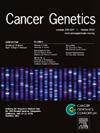3. Interplatform comparison of Stratys and Saphyr: Preliminary results of OGM clinical verification in hematologic cancers
IF 1.4
4区 医学
Q4 GENETICS & HEREDITY
引用次数: 0
Abstract
Introduction
Optical genome mapping using the Bionano Saphyr platform has been deployed as the front-line diagnostic test for acute leukemias at Vancouver General Hospital. The new OGM platform iteration, Stratys, incorporates updates aimed at increasing throughput and is under evaluation to facilitate ramp-up of OGM-based testing in our clinical laboratory. We describe preliminary results of a clinical verification of Stratys, through comparison with the Saphyr, in diagnostic evaluation of hematologic malignancies.
Methods
We processed and annotated 10 specimens from patients with AML (6), ALL (3), and MDS (1) using manufacturer-recommended protocols on Saphyr (rare variant analysis pipeline) and Stratys (low allele fraction guided assembly pipeline). Data quality metrics and identified variants (filtered using provided control datasets and laboratory-developed gene-based filtering approaches) were compared between platforms.
Results
All 32 variants meeting our laboratory's clinical reporting standards using Saphyr were detected using Stratys. Data quality metrics differed negligibly for cases between platforms. Unfiltered Stratys data included substantially more duplication calls (median 64% increase over Saphyr) but population-filtered variants were similar in number between platforms. In representative variants (including translocations/deletions/chromosome gain/loss), breakpoint nucleotide positions were typically identical or, infrequently, differed by less than 10kb interplatform, and variant frequency measures typically differed by 8% on average (without a clear interplatform bias).
Conclusion
Preliminary analysis of verification data indicates Stratys to perform comparably to Saphyr for detection of reportable somatic variants in clinical bone marrow specimens, albeit with relative changes in variant call rates (for variants we currently consider non-reportable) and reported variant burdens.
3.Stratys 和 Saphyr 的平台间比较:血液癌症 OGM 临床验证的初步结果
导言:使用 Bionano Saphyr 平台的光学基因组图谱已被温哥华总医院用作急性白血病的一线诊断检测。新的 OGM 平台迭代版 Stratys 包含了旨在提高吞吐量的更新,目前正在接受评估,以促进我们临床实验室基于 OGM 的测试的升级。我们通过与 Saphyr 的比较,描述了 Stratys 在血液恶性肿瘤诊断评估中的初步临床验证结果。方法我们使用 Saphyr(罕见变异分析管道)和 Stratys(低等位基因分数引导组装管道)上的制造商推荐方案,处理并注释了来自 AML(6 例)、ALL(3 例)和 MDS(1 例)患者的 10 份标本。比较了不同平台的数据质量指标和鉴定出的变异(使用提供的对照数据集和实验室开发的基于基因的过滤方法进行过滤)。结果使用 Saphyr 检测出的所有 32 个变异都符合我们实验室的临床报告标准,使用 Stratys 也检测出了这些变异。不同平台的病例数据质量指标差异微乎其微。未经过滤的 Stratys 数据包含更多的重复调用(与 Saphyr 相比,中位数增加了 64%),但不同平台的群体过滤变异在数量上相似。在有代表性的变异(包括易位/缺失/染色体增益/缺失)中,断点核苷酸位置在平台间通常相同或相差不到 10kb,变异频率测量通常平均相差 8%(没有明显的平台间偏差)。结论对验证数据的初步分析表明,Stratys 在检测临床骨髓标本中可报告的体细胞变异方面的性能与 Saphyr 相当,尽管在变异调用率(我们目前认为不可报告的变异)和报告变异负担方面有相对变化。
本文章由计算机程序翻译,如有差异,请以英文原文为准。
求助全文
约1分钟内获得全文
求助全文
来源期刊

Cancer Genetics
ONCOLOGY-GENETICS & HEREDITY
CiteScore
3.20
自引率
5.30%
发文量
167
审稿时长
27 days
期刊介绍:
The aim of Cancer Genetics is to publish high quality scientific papers on the cellular, genetic and molecular aspects of cancer, including cancer predisposition and clinical diagnostic applications. Specific areas of interest include descriptions of new chromosomal, molecular or epigenetic alterations in benign and malignant diseases; novel laboratory approaches for identification and characterization of chromosomal rearrangements or genomic alterations in cancer cells; correlation of genetic changes with pathology and clinical presentation; and the molecular genetics of cancer predisposition. To reach a basic science and clinical multidisciplinary audience, we welcome original full-length articles, reviews, meeting summaries, brief reports, and letters to the editor.
 求助内容:
求助内容: 应助结果提醒方式:
应助结果提醒方式:


